漲知識!用邏輯規則進行機器學習
在準確率-召回率曲線上,同樣的點是用不同的座標軸繪製的。警告:左邊的第一個紅點(0%召回率,100%精確度)對應0條規則。左邊的第二個點是第一個規則,等等。
Skope-rules使用樹模型產生規則候選項。首先建立一些決策樹,並將從根節點到內部節點或葉節點的路徑視為規則候選項。然後透過一些預先定義的標準(如精確度和召回率)對這些候選規則進行過濾。只有那些精確度和召回率高於其閾值的才會被保留。最後,應用相似性過濾來選擇具有足夠多樣性的規則。一般情況下,應用Skope-rules來學習每個根本原因的潛在規則。

專案網址:https://github.com/scikit-learn-contrib/skope-rules
- Skope-rules是一個建立在scikit-learn之上的Python機器學習模組,在3條款BSD許可下發布。
- Skope-rules旨在學習邏輯的、可解釋的規則,用於 "界定 "目標類別,即高精度地檢測該類別的實例。
- Skope-rules是決策樹的可解釋性和隨機森林的建模能力之間的一種權衡。
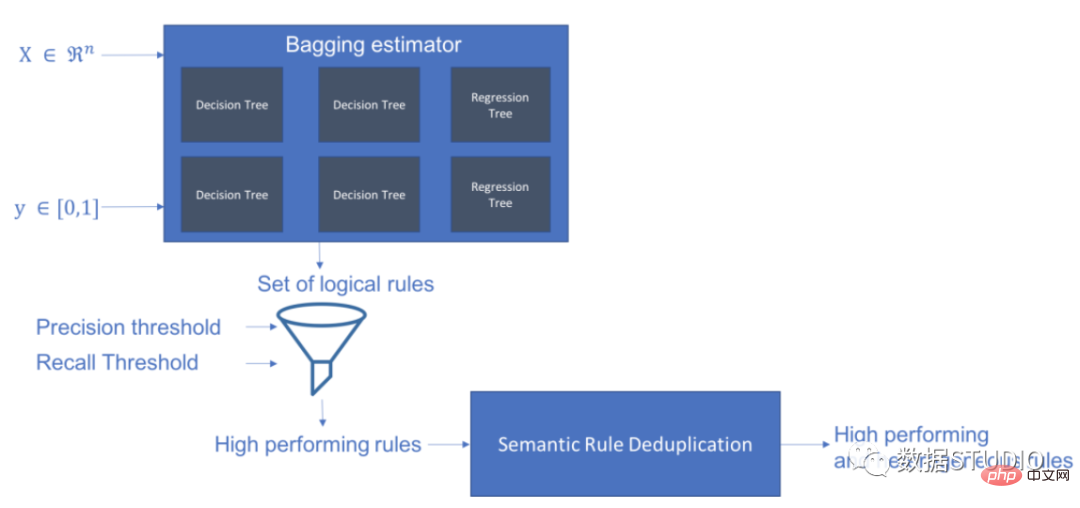
schema
安裝
#可以使用pip 取得最新資源:
pip install skope-rules
快速開始
SkopeRules 可用來描述具有邏輯規則的類別:
from sklearn.datasets import load_iris
from skrules import SkopeRules
#dataset
dataset = load_iris()
feature_names = ['sepal_length', 'sepal_width', 'petal_length', 'petal_width']
clf = SkopeRules(max_depth_duplicatinotallow=2,
clf = SkopeRules(max_depth_duplicatinotallow=2,
clf = SkopeRules(max_depth_duplicatinotallow=2,
n_estimators_##30,_#30,_#. ,
recall_min=0.1,
feature_names=feature_names)
for idx, species in enumerate(dataset.target_names):
X, y = dataset.data, dataset.target
clf.fit(X, y == idx)
rules = clf.rules_[0:3]
print("Rules for iris", species)
for rule in rules:
print( rule)print()
print(20*'=')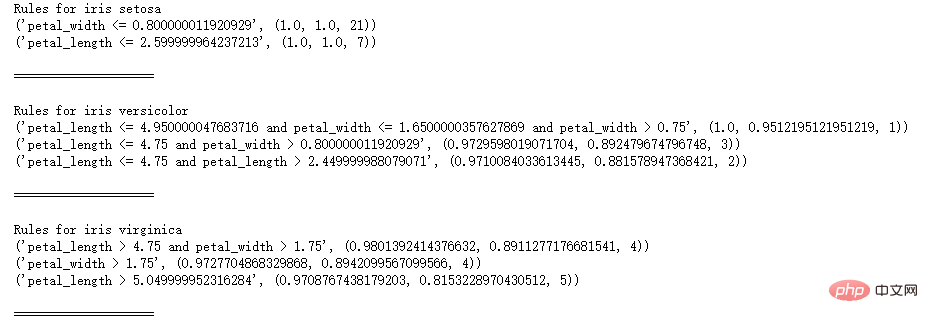 print()
print()
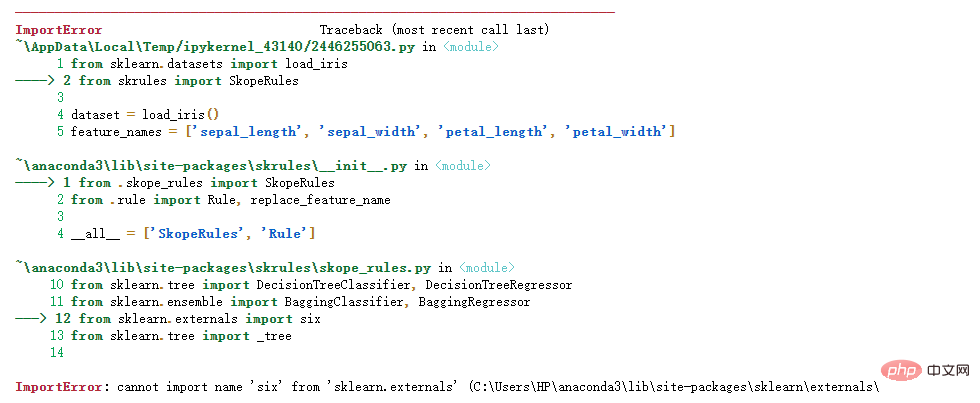 如果出現下列錯誤:
如果出現下列錯誤:
解決方案如下
import siximport sys
sys.modules['sklearn .externals.six'] = six
import mlrose親測有效!
如果使用「score_top_rules」方法,SkopeRules 也可以用作預測器:
from sklearn.datasets import load_boston
from sklearn.metrics import precision_recall_curve#plot#from pyplotplot plt
from skrules import SkopeRules
dataset = load_boston()
clf = SkopeRules(max_depth_duplicatinotallow=None,
n_estimators=30,
precision_min=0.2,##. n_estimators=30,
precision_min=0.2,#0. ,
feature_names=dataset.feature_names)
X, y = dataset.data, dataset.target > 25
X_train, y_train = X[:len(y)//2], y [:len(y)//2]
X_test, y_test = X[len(y)//2:], y[len(y)//2:]
clf.fit(X_train, y_train )
y_score = clf.score_top_rules(X_test) # Get a risk score for each test example
precision, recall, _ = precision_recall_curve(y_test, y_score)
plt.plot(recall, presionve()#cision plt.xlabel('Recall')
plt.ylabel('Precision')
plt.title('Precision Recall curve')plt.show()
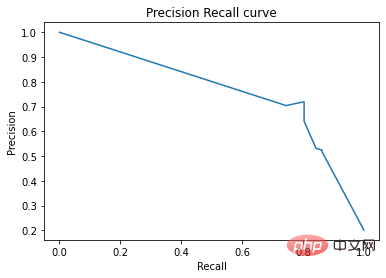
- 解決二分類問題
- 提取可解釋的決策規則
本案例分為5個部分
- 匯入相關庫
- 資料準備
- 模型訓練(使用ScopeRules().score_top_rules()方法)
- 解釋"生存規則"(使用SkopeRules().rules_屬性)。
- 效能分析(使用SkopeRules.predict_top_rules()方法)。
導入相關函式庫
# Import skope-rules
from skrules import SkopeRules
# Import librairies
import pandas as pd
from sklearn.ensemble import GradientBoostingClassifier, RandomForestClassifier
from sklearn.model_selection import train_test_split
from sklearn.tree import DecisionTreeClassifier##import matplotlib.pveplotplotplotps.
from matplotlib import cm
import numpy as np
from sklearn.metrics import confusion_matrix
from IPython.display import display
# Import Titanic data
data = pd.read_csv('
Import Titanic datadata = pd.read_csv('
資料準備
# 刪除年齡缺失的行
data = data.query('Age == Age')
# 為變數Sex建立編碼值
data['isFemale'] = (data['Sex'] == 'female') * 1
# 未變數Embarked建立編碼值
data = pd.concat(
[data,
pd.get_dummies(data.loc[:,'Embarked'],
dummy_na=False,
prefix='Embarked',
prefix_sep='_')],
axis=1
)
# 刪除沒有使用的變數
data = data.drop(['Name', 'Ticket', 'Cabin',
'PassengerId', 'Sex ', 'Embarked'],
axis = 1)
# 建立訓練及測試集
X_train, X_test, y_train, y_test = train_test_split(
data.drop(['Survived'], axis =1),
data['Survived'],
test_size=0.25, random_state=42)
feature_names = X_train.columns
print('Column names are: ' ' '. join(feature_names.tolist()) '.')
print('Shape of training set is: ' str(X_train.shape) '.')
Column names are: Pclass Age SibSp Parch Fare
isFemale Embarked_C Embarked_Q Embarked_S.
Shape of training set is: (535, 9).
模型訓練
## 訓練一個梯度提升分類器,用於基準測試
gradient_boost_clf = GradientBoostingClassifier(random_state=42, n_estimators=30, max_depth = 5)
gradient_boost_clf.fit(X_train, y_train)
# 訓練一個隨機森林分類器,用於基準測試
random_forest_clf = RandomForestClassifier(random_state=42, n_estimators=30, max_depth = 5)
random_forest_clf.fit(X_train, y_train)
##cldetree DecisionTreeClassifier(random_state=42, max_depth = 5)
decision_tree_clf.fit(X_train, y_train)
## 訓練一個skope-rules-boosting 分類器
skope_rules_clf = Skopeles( 42, n_estimators=30,
recall_min=0.05, precision_min=0.9,
max_samples=0.7,
max_depth_duplicatinotallow= 4, max_depth = 5)#s#skope_rules_licatinotallow= 4, max_depth = 5)##skope_rules_licatinotallow
計算預測分數
gradient_boost_scoring = gradient_boost_clf.predict_proba(X_test)[:, 1]
random_forest_scoring = random_forest_clf.predict_proba(X_test)[Ftree:, 1]#.d wring =dm&Ft_prod)[ X_test)[:, 1]
skope_rules_scoring = skope_rules_clf.score_top_rules(X_test)
"生存規則" 的提取
## 獲得創建的生存規則的數量
print("用SkopeRules建立了" str(len(skope_rules_clf.rules_)) "條規則n")
# 列印這些規則
rules_explanations = [
"3歲以下和37歲以下,在頭等艙或二等艙的女性。 "
"3歲以上搭乘頭等艙或二等艙,支付超過26歐元的女性。 "
"坐一等艙或二等艙,支付超過29歐元的女性。 "
"年齡在39歲以上,在頭等艙或二等艙的女性。 "
]
print('其中表現最好的4條"泰坦尼克號生存規則" 如下所示:/n')
for i_rule, rule in enumerate(skope_rules_clf.rules_[:4] )
print(rule[0])
print('->' rules_explanations[i_rule] 'n')
用SkopeRules建立了9條規則。
其中表現最好的4條"泰坦尼克號生存規則" 如下所示:
Age 2.5
and Pclass 0.5
# -> 3歲以下和37歲以下,在頭等艙或二等艙的女性。
Age > 2.5 and Fare > 26.125
and Pclass 0.5
-> 3歲以上搭乘頭等艙或二等艙,支付超過26歐元的女性。
Fare > 29.356250762939453
and Pclass 0.5
-> 坐一等艙或二等艙,支付超過29歐元的女性。
Age > 38.5 and Pclass and isFemale > 0.5
-> 年齡在39歲以上,在頭等艙或二等艙的女性。
def compute_y_pred_from_query(X, rule):
score = np.zeros(X.shape[0])
X = X.reset_index(drop=True)
score[list( X.query(rule).index)] = 1
return(score)
def compute_performances_from_y_pred(y_true, y_pred, index_name='default_index'):
df = pd.DataFrame(data=
{
'precision':[sum(y_true * y_pred)/sum(y_pred)],
'recall':[sum(y_true * y_pred)/sum(y_true)]
},
index=[index_name],
columns=['precision', 'recall']
)
return(df)
def compute_train_test_query_performances(X_train, y_train, X_test, y_test , rule):
y_train_pred = compute_y_pred_from_query(X_train, rule)
y_test_pred = compute_y_pred_from_query(X_test, rule)
##performances = Nonedcatform. #performances,
compute_performances_from_y_pred(y_train, y_train_pred, 'train_set')],
axis=0)
performances = pd.concat([
performances,#test_)
performances = pd.concat([
performances,#test_test_compute_performance_pred_pred_pred_pred_m test_set')],
axis=0)
return(performances)
print('Precision = 0.96 表示規則決定的96%的人是倖存者。 ')
print('Recall = 0.12 表示規則識別的倖存者佔倖存者總數的12%n')
for i in range(4):
print('Rule ' str (i 1) ':')
display(compute_train_test_query_performances(X_train, y_train,
X_test, y_test,
skope_rules_clf.rules_[i][0])
)##skope_rules_clf.rules_[i][0])
)## = 0.96 表示規則確定的96%的人是倖存者。
Recall = 0.12 表示規則識別的倖存者佔倖存者總數的12%。
模型效能偵測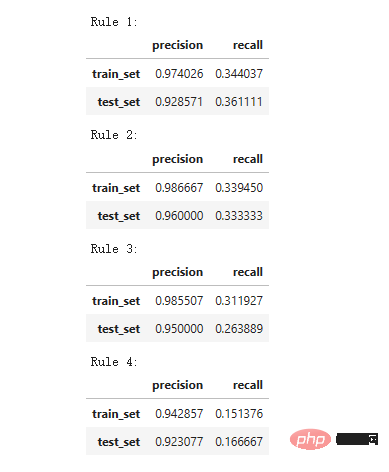
labels_with_line=['Gradient Boosting', 'Random Forest', 'Decision Tree'],
labels_with_points=['skope-rules']):gradient = np.linspace(0, 1, 10)
color_list = [ cm .tab10(x) for x in gradient ]
fig, axes = plt.subplots(1, 2, figsize=(12, 5),
sharex=True, sharey=True)
ax = axes[0]
n_line = 0
for i_score, score in enumerate(scores_with_line):
n_line = n_line 1
fpr, tpr, _ = roc_curve(y_true, score)
ax.plot(fpr, tpr, linestyle='-.', c=color_list[i_score], lw=1, label=labels_with_line[i_score])
for i_score, score in enumerate(scores_with_points):
fpr , tpr, _ = roc_curve(y_true, score)
ax.scatter(fpr[:-1], tpr[:-1], c=color_list[n_line i_score], s=10, label=labels_with_points[i_score] )
ax.set_title("ROC", fnotallow=20)
ax.set_xlabel('False Positive Rate', fnotallow=18)
ax.set_ylabel('True Positive Rate (Recall)', fnotallow =18)
ax.legend(loc='lower center', fnotallow=8)
ax = axes[1]
n_line = 0
for i_score, score in enumerate(scores_with_line ):
n_line = n_line 1
precision, recall, _ = precision_recall_curve(y_true, score)
ax.step(recall, precision, linestyle='-.', c=color_list[i_score], lw =1, where='post', label=labels_with_line[i_score])
for i_score, score in enumerate(scores_with_points):
precision, recall, _ = precision_recall_curve(y_true, score)##ax.scatter (recall, precision, c=color_list[n_line i_score], s=10, label=labels_with_points[i_score])
ax.set_title("Precision-Recall", fnotallow=20)
ax.set_xlabel('Recall (True Positive Rate)', fnotallow=18)
ax.set_ylabel('Precision', fnotallow=18)
ax.legend(loc='lower center', fnotallow=8)
plt.show ()
plot_titanic_scores(y_test,
scores_with_line=[gradient_boost_scoring, random_forest_scoring, decision_tree_scoring],
scores_with_points=[skope_rules_scoring]
#. ##在ROC曲線上,每個紅點對應於啟動的規則(來自skope-rules)的數量。例如,最低點是1個規則(最好的)的結果點。第二低點是2條規則結果點,以此類推。
在準確率-召回率曲線上,同樣的點是用不同的座標軸繪製的。警告:左邊的第一個紅點(0%召回率,100%精確度)對應0條規則。左邊的第二個點是第一個規則,等等。
從這個例子可以得到一些結論。
- skope-rules的表現比決策樹好。
- skope-rules的表現與隨機森林/梯度提升相似(在這個例子中)。
- 使用4個規則可以獲得很好的性能(61%的召回率,94%的精確度)(在這個例子中)。
n_rule_chosen = 4
y_pred = skope_rules_clf.predict_top_rules(X_test, n_rule_chosen)
print('The performances reached with ' strare_rulewing_rules 隨身 fver. ')
compute_performances_from_y_pred(y_test, y_pred, 'test_set')

predict_top_rules(new_data, n_r)方法用來計算對new_data的預測,其中n_r_rd skope-rules規則。
以上是漲知識!用邏輯規則進行機器學習的詳細內容。更多資訊請關注PHP中文網其他相關文章!

熱AI工具

Undresser.AI Undress
人工智慧驅動的應用程序,用於創建逼真的裸體照片

AI Clothes Remover
用於從照片中去除衣服的線上人工智慧工具。

Undress AI Tool
免費脫衣圖片

Clothoff.io
AI脫衣器

Video Face Swap
使用我們完全免費的人工智慧換臉工具,輕鬆在任何影片中換臉!

熱門文章

熱工具

記事本++7.3.1
好用且免費的程式碼編輯器

SublimeText3漢化版
中文版,非常好用

禪工作室 13.0.1
強大的PHP整合開發環境

Dreamweaver CS6
視覺化網頁開發工具

SublimeText3 Mac版
神級程式碼編輯軟體(SublimeText3)
 漲知識!用邏輯規則進行機器學習
Apr 01, 2023 pm 10:07 PM
漲知識!用邏輯規則進行機器學習
Apr 01, 2023 pm 10:07 PM
在準確率-召回率曲線上,同樣的點是用不同的座標軸繪製的。警告:左邊的第一個紅點(0%召回率,100%精確度)對應0條規則。左邊的第二個點是第一個規則,等等。 Skope-rules使用樹模型產生規則候選項。首先建立一些決策樹,並將從根節點到內部節點或葉節點的路徑視為規則候選項。然後透過一些預先定義的標準(如精確度和召回率)對這些候選規則進行過濾。只有那些精確度和召回率高於其閾值的才會被保留。最後,應用相似性過濾來選擇具有足夠多樣性的規則。一般情況下,應用Skope-rules來學習每個根本原因的
 OpenOOD更新v1.5:全面、精確的分佈外偵測程式碼庫及測試平台,支援線上排行榜、一鍵測試
Jul 03, 2023 pm 04:41 PM
OpenOOD更新v1.5:全面、精確的分佈外偵測程式碼庫及測試平台,支援線上排行榜、一鍵測試
Jul 03, 2023 pm 04:41 PM
分布外(OOD)检测对于开放世界智能系统的可靠运行至关重要,但目前面向对象的检测方法存在「评估不一致」(evaluationinconsistencies)的问题。之前的工作OpenOODv1统一了OOD检测的评估,但在可扩展性和可用性方面仍然存在限制。最近开发团队再次提出OpenOODv1.5,相比上一版本,新的OOD检测方法评估在确保准确、标准化和用户友好等方面得到显著提升。图片Paper:https://arxiv.org/abs/2306.09301OpenOODCodebase:htt
 如何在Java中找到運行時提供的參數數量?
Sep 23, 2023 pm 01:13 PM
如何在Java中找到運行時提供的參數數量?
Sep 23, 2023 pm 01:13 PM
在Java中,在執行時間傳遞參數的一種方法是使用命令列或終端機。在檢索命令列參數的這些值時,我們可能需要查找使用者在執行時間提供的參數數量,這可以藉助length屬性來實現。本文旨在藉助範例程式解釋傳遞和獲取使用者提供的參數數量的過程。在取得使用者在執行時提供的參數數量在尋找命令列參數的數量之前,我們的第一步是建立一個允許使用者在執行時間傳遞參數的程式。字串[]參數在寫Java程式時,我們經常遇到main()方法。當JVM呼叫此方法時,Java應用程式開始執行。它與一個名為String[]args的參數一起使
 Linux指令:查看telnet進程數量的方法
Mar 01, 2024 am 11:39 AM
Linux指令:查看telnet進程數量的方法
Mar 01, 2024 am 11:39 AM
Linux指令是系統管理員日常工作中不可或缺的工具之一,它們可以幫助我們完成各種系統管理任務。在維運工作中,有時候需要查看系統中某個進程的數量以便及時發現問題和進行調優。本文將介紹如何使用Linux指令查看telnet進程的數量,讓我們一起來學習吧。在Linux系統中,我們可以使用ps指令結合grep指令來查看telnet進程的數量。首先,我們需要打開終端,
 使用C++找到遍歷N叉樹的方式的數量
Sep 04, 2023 pm 05:01 PM
使用C++找到遍歷N叉樹的方式的數量
Sep 04, 2023 pm 05:01 PM
給定一個N叉樹,我們的任務是找到遍歷這棵樹的總方式數,例如−對於上面的樹,我們的輸出將是192。對於這個問題,我們需要一些組合學的知識。現在在這個問題中,我們只需要檢查每條路徑的所有可能組合,這將給我們答案。找到解決方案的方法在這個方法中,我們只需要執行一次層次遍歷,檢查每個節點有多少個子節點,然後將其階乘乘以答案。範例上述方法的C++程式碼#include<bits/stdc++.h>usingnamespacestd;structNode{//s
 使用C++編寫程式碼,找到具有相同最小值和最大值的子數組的數量
Aug 25, 2023 pm 11:33 PM
使用C++編寫程式碼,找到具有相同最小值和最大值的子數組的數量
Aug 25, 2023 pm 11:33 PM
在本文中,我們將使用C++解決尋找最大值和最小值相同的子數組數量的問題。以下是該問題的範例−Input:array={2,3,6,6,2,4,4,4}Output:12Explanation:{2},{3},{6},{6},{2 },{4},{4},{4},{6,6},{4,4},{4,4}and{4,4,4}arethesubarrayswhichcanbeformedwithmaximumandminimumelementsame.Input:array={3,3, 1,5,
 二元樹中等腰三角形的數量
Sep 05, 2023 am 09:41 AM
二元樹中等腰三角形的數量
Sep 05, 2023 am 09:41 AM
二元樹是一種資料結構,其中每個節點最多可以有兩個子節點。這些孩子分別稱為左孩子和右孩子。假設我們得到了一個父數組表示,您必須使用它來建立一棵二元樹。二元樹可能有幾個等腰三角形。我們必須找到該二元樹中可能的等腰三角形的總數。在本文中,我們將探討幾種在C++中解決這個問題的技術。理解問題給你一個父數組。您必須以二元樹的形式表示它,以便數組索引形成樹節點的值,而數組中的值給出該特定索引的父節點。請注意,-1始終是根父節點。下面給出的是一個數組及其二元樹表示。 Parentarray=[0,-1,3,1,
 使用C++編寫程式碼,找到具有奇數和的子數組的數量
Sep 21, 2023 am 08:45 AM
使用C++編寫程式碼,找到具有奇數和的子數組的數量
Sep 21, 2023 am 08:45 AM
子數組是數組的連續部分。例如,我們考慮一個數組[5,6,7,8],那麼有十個非空子數組,如(5),(6),(7),(8),(5,6),(6, 7)、(7,8)、(5,6,7)、(6,7,8)和(5,6,7,8)。在本指南中,我們將解釋在C++中尋找所有可能的資訊來尋找具有奇數和的子數組的數量。為了找到奇數和的子數組的數量,我們可以使用不同的方法,所以這裡是一個簡單的例子-Input:array={9,8,7,6,5}Output:9Explanation:Sumofsubarray-{9}= 9{7






